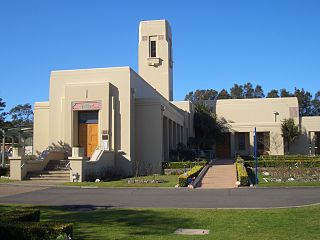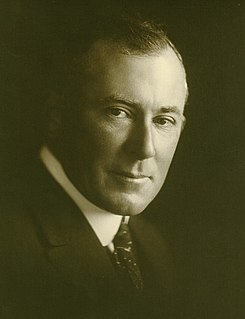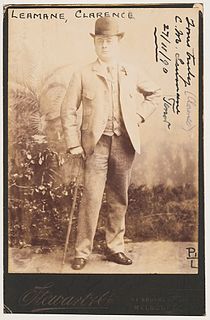
The Gaiety Theatre was an entertainment venue in Sydney, Australia from 1880 to 1900 and then a boxing stadium until 1912.

The Gaiety Theatre was an entertainment venue in Sydney, Australia from 1880 to 1900 and then a boxing stadium until 1912.
The Guild Hall in Castlereagh Street, Sydney, was leased by John Solomon and L. M. Bayless in 1880, refurbished as a comedy theatre seating 1500 and renamed "Gaiety Theatre". [1] [2] Bayless was a sub-lessee. [3]
It was the home of Arthur Garner's London Comedy Company for one season, starring Fred Marshall.
A notable programme was that in 1888 provided by volunteer performers to benefit the victims of the Bombo disaster. Rosa Towers made her first performance there since 1884, when she and her parents made their farewell performance prior to their tour of India, where both died. [4]
In 1900 it became the Gaiety Athletic Club, [5] (a boxing stadium), managed by Charlie Marshall.
In 1912 the building was purchased by the Catholic Club Land and Building Company and it became the Catholic Club. [6]

A coffee palace was an often large and elaborate residential hotel that did not serve alcohol, most of which were built in Australia in the late 19th century.

Bombo is a suburb of the Municipality of Kiama, in the Illawarra region of New South Wales, Australia. It is located 2 kilometres (1.2 mi) north of Kiama.

Eastern Suburbs Memorial Park, Eastern Suburbs Crematorium and Botany General Cemetery, is a cemetery and crematorium on Bunnerong Road in Matraville, New South Wales, in the eastern suburbs district of Sydney, Australia.

Sir John William Ashton, OBE, ROI was a prolific Australian Impressionist artist and director of the National Art Gallery of New South Wales from 1937 to 1943.
Alfred Rolfe, real name Alfred Roker, was an Australian stage and film director and actor, best known for being the son-in-law of the celebrated actor-manager Alfred Dampier, with whom he appeared frequently on stage, and for his prolific output as a director during Australia's silent era, including Captain Midnight, the Bush King (1911), Captain Starlight, or Gentleman of the Road (1911) and The Hero of the Dardanelles (1915). Only one of his films as director survives today.

Clarence M. "Jack" Leumane was an English-born singer, actor, songwriter and librettist. He played leading tenor roles in opera, especially the comic operas of Gilbert and Sullivan, in the 1880s, first in Britain and then Australia. He was also a librettist and writer of the song "The Lambton Worm" in 1867.
White's Rooms, later known as Adelaide Assembly Room, was a privately owned function centre which opened in 1856 on King William Street, Adelaide, South Australia. It became Garner's Theatre in 1880, then passed through several hands, being known as the Tivoli theatre, Bijou theatre, Star picture theatre and finally in 1916 the Majestic Theatre and Hotel.

The Municipality of Mascot was a local government area in the inner south of Sydney, New South Wales, Australia. The municipality was proclaimed as the Borough of North Botany on 29 March 1888 and was renamed to the Municipality of Mascot, in order to differentiate itself from their southern neighbour, from 31 October 1911. It included the modern suburbs of Eastlakes and Daceyville, with parts of Mascot and Pagewood. From 1 January 1949, the council was amalgamated into the Municipality of Botany, with the passing of the Local Government (Areas) Act 1948.
Robert Brough was born in England to a family prominent in literature and the theatre. He had a notable career as actor and manager in Australia.

Long before the famous Sydney Opera House on Bennelong Point, the city of Sydney, Australia, had several entertainment venues described as "opera houses".
The Melbourne Garrick Club was an association of people with interests in the theatre, founded in 1855, and disbanded around 1866 after the death of one of its "leading lights".
The Royal Lyceum was a small theatre in York Street, Sydney founded in 1854, which was redeveloped and renamed many times, finally as the Queen's Theatre, by which name it closed in 1882.
Margaret "Maggie" Knight was a New Zealand actress who had a significant career on the Australian stage.
Frank Towers (1835–1886) was an Australian actor, playwright and stage producer.

George Crichton Miln (1850–1917) was an American actor and stage manager who was active in Australia 1888–1890.
Richard Stewart was an English stage actor who settled in Australia. He is best remembered as the father of Nellie Stewart.
The National Amphitheatre was a boxing stadium and entertainment venue at 73–75 Castlereagh Street, Sydney, New South Wales.
John Brunton was a Scottish scenic artist who worked for theatres in Britain and Australia. He was the father of actor Dorothy Brunton.
William Dind was an hotelier and theatre manager in Sydney, Australia, where he was the longtime lessee of the Royal Victoria, and Prince of Wales theatres. He settled on Sydney's North Shore, where he was active in local government, and he and his son William Forster Dind, aka W. Forster Dind or William Dind jun, ran hotels which were popular with theatrical people.
Mary Gladstane was an Irish-American actress of the 19th-century who had a considerable career in Australia, along with her husband and manager, L. M. Bayless.